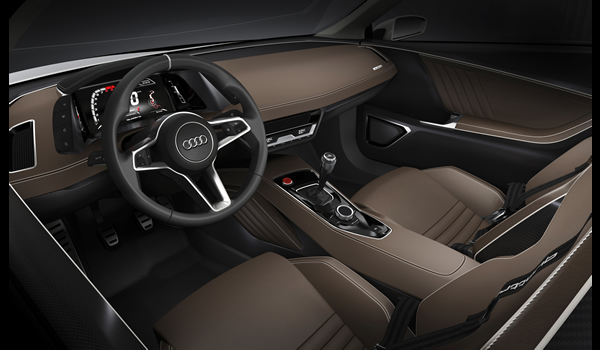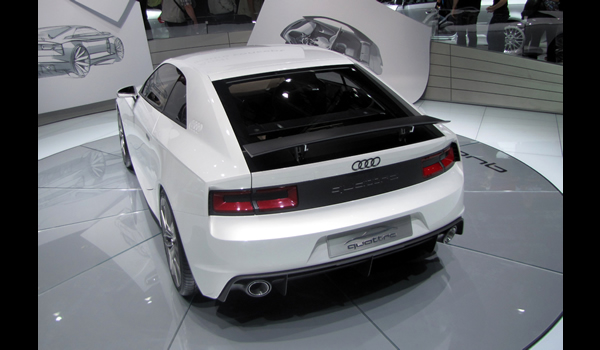Audi Quattro concept 2010
The 1980 Geneva Motor Show saw the debut of an automobile, whose name went on to become more than just a symbol for a long line of success by the manufacturer. The quattro from Audi is also the gold standard for the combination of winning motor sport qualities with the utmost in everyday practicality.
In celebration of the 30th anniversary of the debut of the quattro, Audi is presenting a show car at the 2010 Paris Motor Show that moves a futuristic interpretation of this concept into the fast lane: the Audi quattro concept, a thoroughbred driving machine with 300 kW (408 hp), five-cylinder turbocharged engine, a lightweight body and – of course – the latest generation of quattro permanent all-wheel drive.
The Audi development engineers shortened the wheelbase by 150 millimeters (5.91 in) and lowered the roofline by around 40 millimeters (1.57 in) compared to the four-seat coupé on which it is based. Like its predecessor from 1984, the 2010 show car is now also a two-seater. The heavily modified body is made primarily of aluminum, with the hood, the rear hatch and other components made of carbon.
The low weight of the superstructure leads to significant secondary effects in other components of the vehicle, such as the transmission, the chassis and the brake system. As a result, the Audi quattro concept weights just 1,300 kilograms (2,866.01 lb), almost exactly the same as the Sport quattro from 1984.
“Brawny, compact, powerful”
In contrast to Sport quattro, the Audi designers also shortened the rear overhang by a total of 200 millimeters (7.87 in) to maintain the harmony of the basic proportions. Roof height was reduced by 40 millimeters (1.57 in) for this same reason. 12/19 www.audi-mediaservices.com
With its exterior dimensions (length x width x height) of 4.28 m (14.04 ft) x 1.86 m (6.10 ft) x 1.33 m (4.36 ft) and wheelbase of 2.60 m (8.53 ft), the Audi quattro concept fits neatly into the sports car segment.
The low roof also reduces the height of the greenhouse and thus lowers the vehicle’s visual center of gravity. The muscular C-pillar is clearly an homage to the design of the Ur-quattro.
Interior
The interior of the coupé is reduced and clean. The dashboard is very slender and seems to float over the separate center console. Shortening the wheelbase meant losing the rear seat of the RS 5 on which it is based. In its place is a shelf for helmets or luggage. Awaiting the two occupants are filigree bucket seats, during whose development the issue of lightweight design played a central role. They weigh only 18 kilograms (39.68 lb) each – a weight advantage of roughly 40 percent versus a conventional production seat. The seats are equipped with either three- or four-point belts. |
 |
A true sports car is always a light car, and the Audi quattro concept shines in this discipline as well.
The key factors are the choice of material and the design. Rather than mostly steel as in the Audi RS 5, the body comprises lightweight aluminum components assembled using Audi Space Frame ASF technology. Extruded sections, die-castings and aluminum sheets form an impact-resistant structure of exceptional strength. The hood and the rear hatch with its integrated, moveable spoiler, plus the bumpers and numerous aerodynamic components are made of even lighter and high-strength carbon.
The body-in-white of the coupé weighs just 159 kilograms (350.53 lb); it would be nearly 50 percent heavier if made entirely of steel.
The low weight of the superstructure leads to significant secondary effects regarding size and weight in other components of the vehicle, such as the transmission, the chassis and the brake system. All together the Audi quattro concept tips the scales at just 1,300 kilograms (2,866.01 lb), which is roughly 200 kilograms (440.92 lb) lighter than even the comparably sized Audi TT RS, whose body is also largely made of aluminum.
| The power-to-weight ratio of 4.3 kilograms (9.48 lb) per hp already says a lot about the car’s dynamic potential. It is on par with that of the 525 hp Audi
R8 V10, a veritable supercar. The quattro concept also has a much better power-to-weight ratio than its Sport quattro predecessor. Although the Sport quattro weighed the same, the production version of its five-cylinder engine only developed 306 hp. |
 |
| |
|
Turbocharged gasoline engines are a traditional Audi domain, and the five-cylinder turbo in the Audi quattro concept is also a high-performance engine. Displacing 2,480 cubic centimeters, it produces 300 kW (408 hp) between 5,400 and 6,500 rpm. Peak torque of 480 Nm (354.03 lb ft) is already available at 1,600 and remains constant through 5,300 rpm. The powerful unit accelerates the Audi quattro concept from 0 to 100 km/h (62.14 mph) in 3.9 seconds.
The 2.5 liter TFSI is extremely compact. Its cylinder spacing measures 88 millimeters (3.46 in); the external main bearings were moved inside. Only
494 millimeters (19.45 in) long, the long-stroke engine (bore x stroke 82.5 x 92.8 millimeters [3.25 x 3.65 in]) is suitable not only for transverse installation in the
TT RS, but also for longitudinal installation in the emphatically short front end of the Audi quattro concept.
Its low weight of only 183 kilograms (403.45 lb) is also a record. It helps keep the total weight of the show car low and also offers significant advantages for the distribution of axle loads and thus for the car’s handling.
The 408-hp five-cylinder engine is surprisingly frugal, requiring an average of just 8.5 liters/100 km (27.67 US mpg). Its high efficiency can be attributed to the combination of FSI direct fuel injection and turbocharging, two Audi core technologies. This TFSI pairing harmonizes perfectly in motorsports, the world’s most demanding test lab: It has powered the R8 race car to five victories in the 24 Hours of Le Mans and 63 victories in 80 other races.
Specifications
length x width x height of 4.28 m (14.04 ft) x 1.86 m (6.10 ft) x 1.33 m (4.36 ft)
wheelbase of 2.60 m (8.53 ft)
weights: 1,300 kilograms
Turbocharged gasoline engines: 2,480 cubic centimetres, 300 kW (408 hp) between 5,400 and 6,500 rpm
0 to 100 km/h (62.14 mph) in 3.9 seconds
Wallpapers : Audi quattro concept 2010
|